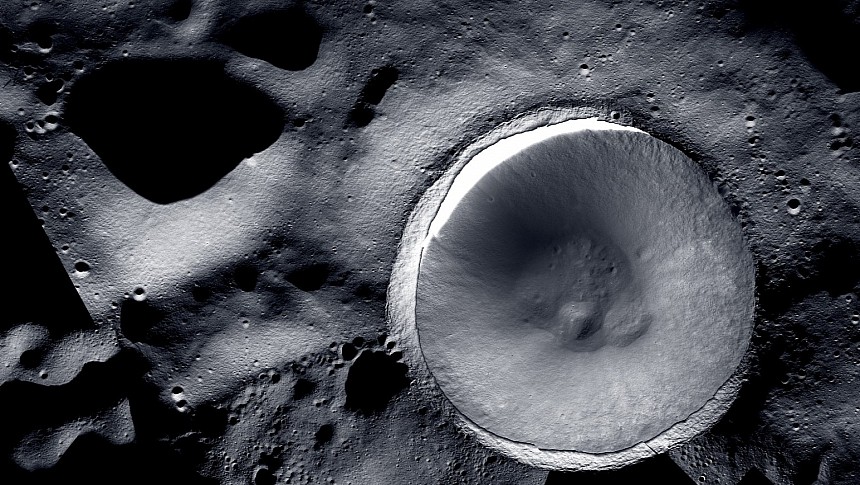NASA's Lunar Reconnaissance Orbiter spends a fair deal of its time photographing craters. Granted, that's par for the course on the Moon, and not every lunar pot mark or meteoroid impact is worth writing home about. Then again, some lunar craters out there manage to inspire a combination of child-like wonder and abject horror that reminds us how fragile we flesh blobs on Earth are. The LRO's latest mosaic of Shackleton Crater is proof of this in action. At 12.4 miles (20 km) across, few craters visible on land on Earth even come close.
Of course, we're talking about Shackleton Crater on the lunar South Pole. A vast depression on the lunar surface that's thought to be rife with resources and scientific discoveries just waiting to be found, and a place that's only just begun to be explored on its surface by man-made probes. Using composite images taken via the LRO's Lunar Reconnaissance Orbiter Camera (LROC), as well as a NASA instrument set installed on the Koran Danuri spacecraft called the ShadowCam, we now have as stunning of a shot of the massive lunar structure as humanity has ever seen. From this high-up vantage point in lunar orbit, it's possible to understand the vast scale of the impact that formed this crater eons ago.
At some point in the distant past, an assuredly vast piece of unknown space debris impacted the Moon at the modern-day site of Shackleton Crater. Upon impact, the result was somewhat similar to dropping a large, heavy stone into a body of water. But instead of splashing water in a 360-degree vicinity of the impact, this happened with semi-molten liquidus rock heated to thousands of degrees by the beyond-biblical impact for forces involved.
Through the twin orbiter probe's analysis, we can see the easily identifiable splashback point where super-heated impact ejected spewed out across the lunar South Pole before settling back down on the surface. Ironically enough, the bottom of Shackleton Crater has polar opposite temperature qualities nowadays than when it first formed. Because the crater's deepest depths are cold enough to make astronaut popsicles, it's theorized that all the goodies delivered to the lunar surface via asteroid and comet impacts are still perfectly preserved.
Such elemental treasures include helium-3, ripe for nuclear fusion fuel, and possibly even more well-known energy sources like fissile uranium and thorium. It also includes more mundane but no-less vital molecules like water ice, which future lunar inhabitants could use as a source of drinking water, but also chemically separate into oxygen and hydrogen to make rocket fuel and oxidizer. You probably couldn't tell any of this from a passing glance at this photo of Shackleton Crater. But there's a reason NASA sees the region as a prime target for humans to explore. Heck, there's a robot on its surface as we speak.
At some point in the distant past, an assuredly vast piece of unknown space debris impacted the Moon at the modern-day site of Shackleton Crater. Upon impact, the result was somewhat similar to dropping a large, heavy stone into a body of water. But instead of splashing water in a 360-degree vicinity of the impact, this happened with semi-molten liquidus rock heated to thousands of degrees by the beyond-biblical impact for forces involved.
Through the twin orbiter probe's analysis, we can see the easily identifiable splashback point where super-heated impact ejected spewed out across the lunar South Pole before settling back down on the surface. Ironically enough, the bottom of Shackleton Crater has polar opposite temperature qualities nowadays than when it first formed. Because the crater's deepest depths are cold enough to make astronaut popsicles, it's theorized that all the goodies delivered to the lunar surface via asteroid and comet impacts are still perfectly preserved.
Such elemental treasures include helium-3, ripe for nuclear fusion fuel, and possibly even more well-known energy sources like fissile uranium and thorium. It also includes more mundane but no-less vital molecules like water ice, which future lunar inhabitants could use as a source of drinking water, but also chemically separate into oxygen and hydrogen to make rocket fuel and oxidizer. You probably couldn't tell any of this from a passing glance at this photo of Shackleton Crater. But there's a reason NASA sees the region as a prime target for humans to explore. Heck, there's a robot on its surface as we speak.






